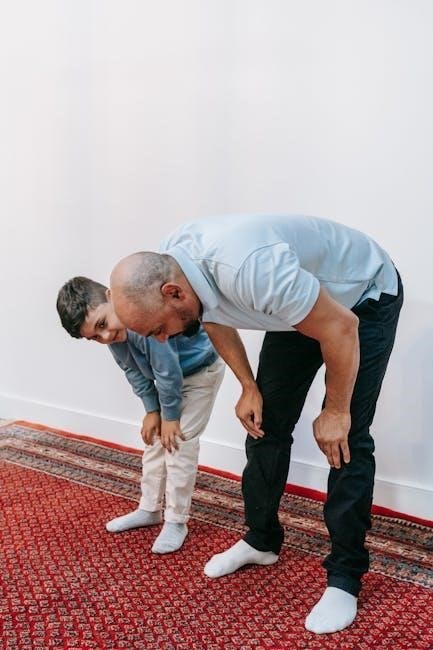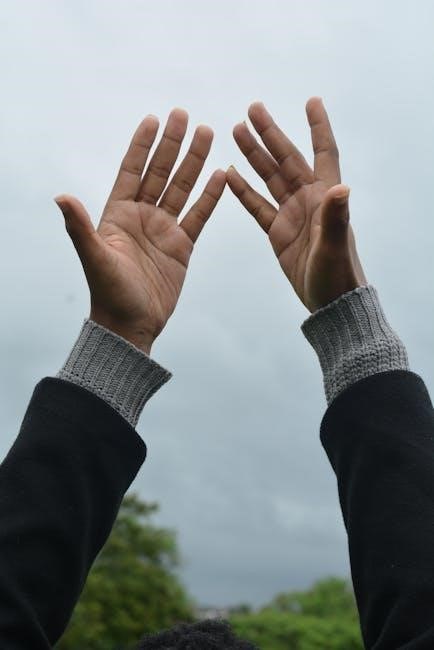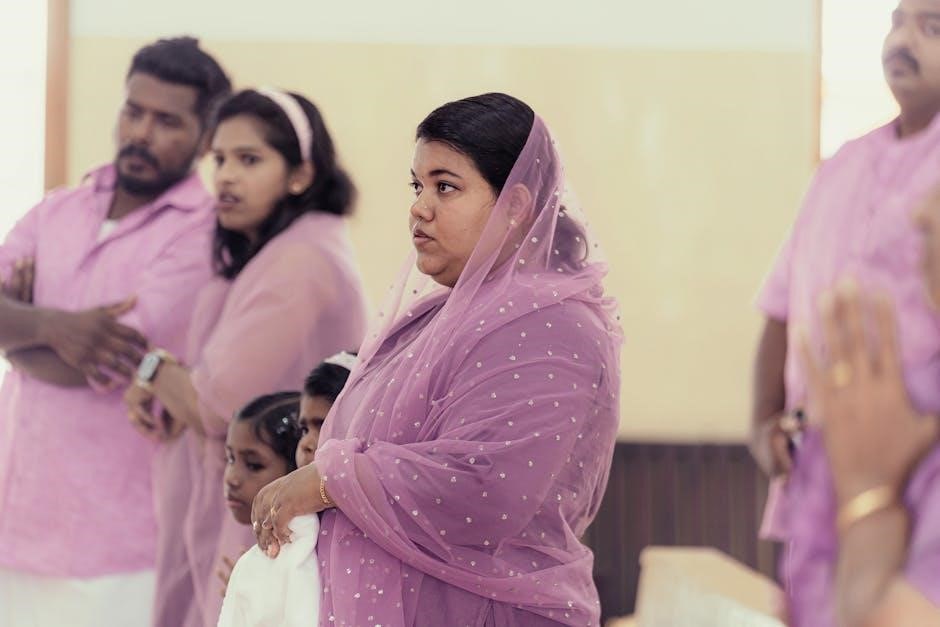What is Janaza Prayer?
Salat al-Janazah is the Islamic funeral prayer. It is a communal obligation and is performed in congregation to seek pardon for the deceased and all dead Muslims. There are no Rukus or Sujud in this prayer.
Definition and Significance
The Janaza prayer, or Salat al-Janazah, is a crucial Islamic ritual performed as a communal obligation for a deceased Muslim. This prayer, offered in congregation, seeks forgiveness and blessings for the departed soul. It is a unique prayer, distinguished by the absence of bowing (Ruku) and prostration (Sujud), emphasizing supplication and remembrance of Allah. The Janazah prayer underscores the Islamic values of community support, empathy, and the recognition of mortality. Its performance signifies unity among Muslims in honoring the deceased, offering comfort to the bereaved family, and seeking Allah’s mercy for the departed. The prayer’s significance lies in its role as a final act of devotion and respect, reinforcing the spiritual connection between the living and the deceased within the Muslim community.

Conditions for Janaza Prayer
Like all prayers, purity is essential. This includes performing Wudu (ablution) before the Janaza prayer. Clean clothes and a clean physical state are required for offering this prayer.
Purity and Wudu
Similar to regular prayers, tahara (purity) is a vital condition for performing Salat al-Janazah. This encompasses both physical cleanliness and spiritual purification. Before engaging in the Janaza prayer, individuals must perform Wudu, the Islamic ablution. This ritual washing involves cleansing specific body parts with water, including the face, hands, arms, head, and feet.
Ensuring cleanliness of one’s clothes and body is also essential. This adherence to purity demonstrates respect for Allah and the deceased. Maintaining a state of Wudu signifies readiness to engage in prayer and seek forgiveness for the departed soul. It reflects the importance of both inner and outer purity in Islamic worship.
Intention (Niyyah)
Before commencing the Janaza prayer, making the correct Niyyah, or intention, is crucial. The Niyyah is a sincere declaration of purpose in the heart, signifying the specific prayer being offered. In the case of Janaza, the intention should be to perform the funeral prayer for the deceased Muslim.
This intention is a fundamental element of the prayer, distinguishing it from other acts of worship. The Niyyah must be present in the heart. The intention acknowledges the purpose of the prayer, directs the heart towards Allah, and seeks forgiveness for the departed soul. It is a vital component that validates the act of worship.

How to Perform Janaza Prayer
The prayer is performed while standing. There are NO Rukuh, Sujud, Athan, or Iqama. It includes four Takbirs (saying Allahu Akbar). Dua is made asking Allah to forgive the deceased and have mercy on them.
Standing Position and No Rukus or Sujud
In Salat al-Janazah, participants stand in congregation with the body of the deceased placed in front. Notably, there are no Rukus (bowing) or Sujud (prostrations) performed in this prayer, distinguishing it from regular daily prayers. The absence of these physical actions emphasizes the focus on supplication and seeking forgiveness for the departed soul. The Imam stands in front, typically aligned with the middle of the body if it’s a male, and near the chest if it’s a female, leading the congregation through the prescribed recitations and prayers. This unique format underscores the solemnity and purpose of the Janazah prayer, which is to implore Allah for His mercy and blessings upon the deceased. The prayer consists primarily of standing, making intentions, reciting specific supplications, and offering salutations.
The Four Takbirs
The core structure of the Janazah prayer involves reciting four Takbirs, each followed by specific recitations and supplications. A Takbir is the act of saying “Allahu Akbar” (God is the Greatest). After the initial Takbir, Surat Al-Fatihah is recited. The second Takbir is followed by the Durood Shareef, a prayer of blessings upon Prophet Muhammad (peace be upon him). Following the third Takbir, a Dua (supplication) is made specifically for the deceased. The fourth and final Takbir is followed by a Dua for all Muslims, living and deceased. These Takbirs serve as integral markers within the prayer, guiding the sequence of recitations and prayers offered for the departed soul. This structured approach ensures a comprehensive and meaningful supplication for the deceased and the Muslim community.

Recitations After Takbirs
Following each of the four Takbirs in the Janazah prayer, specific recitations are made. These include Surat Al-Fatihah, Durood Shareef, Dua for the deceased, and Dua for the Muslim Ummah, offering comprehensive supplications.
Recitations After Takbirs
Surat Al-Fatihah (after the first Takbir)
After the first Takbir in the Janazah prayer, it is a practice to recite Surat Al-Fatihah. This recitation follows the pronouncement of “Allahu Akbar.” Reciting Surat Al-Fatihah is an essential part of Islamic prayers. It underscores the importance of seeking guidance and mercy from Allah.
The practice involves reciting Surat Al-Fatihah silently. This recitation is a way to seek blessings for the deceased. It is also a way to express faith and humility before Allah during this solemn ritual.
The inclusion of Surat Al-Fatihah highlights the significance of connecting with Allah through prayer. The prayer provides comfort and solace during times of loss. This is an integral part of the Janazah prayer, which emphasizes spiritual reflection.
Durood Shareef (after the second Takbir)
Following the second Takbir in the Janazah prayer, the next step is to recite Durood Shareef. This involves sending blessings upon Prophet Muhammad (peace be upon him). Reciting Durood Shareef is a significant act of reverence and devotion. It is considered a way to seek Allah’s blessings and mercy.
This practice highlights the importance of honoring the Prophet. It also seeks his intercession for the deceased. The Durood Shareef can be any of the well-known forms, such as Durood-e-Ibrahimi.
The inclusion of Durood Shareef in the Janazah prayer reflects the deep love and respect Muslims have for Prophet Muhammad. It is also a way to seek spiritual elevation for the deceased. This is an essential part of the prayer, emphasizing faith and reverence.
Dua for the Deceased (after the third Takbir)
After the third Takbir in the Janazah prayer, a specific Dua (supplication) is recited for the deceased person. This Dua is a heartfelt plea to Allah. It asks for forgiveness, mercy, and blessings for the departed soul. It is a crucial part of the prayer, focusing entirely on the well-being of the deceased in the afterlife.
The Dua typically includes seeking Allah’s pardon for their sins. It also asks for ease in their grave and elevation of their status in Jannah (Paradise). The precise wording of the Dua can vary. However, the intention remains the same: to beseech Allah to grant the deceased His grace and compassion. This act reflects the Islamic belief in the power of prayer for the departed.
Dua for the Muslims (after the fourth Takbir)
Following the fourth Takbir in the Janazah prayer, a Dua (supplication) is recited for the Muslim community. This Dua is a prayer for the living and the deceased. It seeks Allah’s blessings, forgiveness, and guidance for all Muslims.
The supplication often includes a request for Allah to grant patience and strength to the family of the deceased. It also asks for unity and well-being within the Muslim Ummah (community). While some narrations suggest specific Duas, any sincere prayer for the benefit of Muslims is acceptable. The essence is to remember and support the entire community in times of loss. This act emphasizes the interconnectedness of Muslims in life and death.

Concluding the Prayer
Tasleem (As-salāmu ʿalaikum wa-raḥmatu-llah)
The Janazah concludes with the standard Tasleem. The Imam says “As-salāmu ʿalaikum wa-raḥmatu-llah” (Peace and blessings of God be unto you). This phrase is repeated, turning the head to the right, ending the prayer.
Tasleem (As-salāmu ʿalaikum wa-raḥmatu-llah)
The Janazah prayer concludes with the Tasleem, a standard closing for Islamic prayers. The Imam leads by saying, “As-salāmu ʿalaikum wa-raḥmatu-llah,” which translates to “Peace and blessings of God be upon you.” This phrase is recited twice. The Imam first turns the head towards the right side while saying the phrase for the first time, and then repeats the same phrase while turning his head towards the left side. This signifies extending peace and blessings to everyone present. By performing the tasleem, the prayer is complete, marking the end of the Janazah prayer and the beginning of the next steps in the funeral process, such as the respectful burial of the deceased in a Muslim cemetery, and the prayers and support offered to the family.
